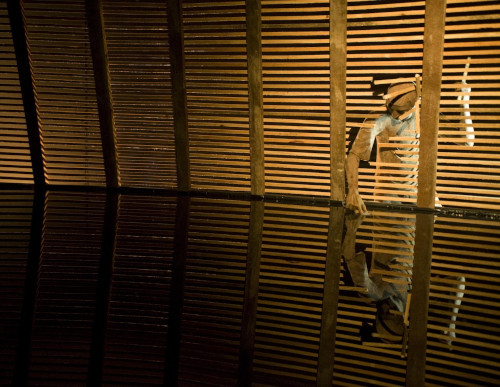

The SCI is not so much a protection area is an area in which the species are monitored and then measures are taken, if necessary. The aim is to make a scientific monitoring of these areas and we can say that there is no major impact on these populations and in case it starts or not we can take measures. In the case of Madeira, the situation was reversed. Before the creation of SCI, situations that were managed in a timely manner, as was the case of whale-watching and already come out legislation that allows that the framework for the activity was created.
The third point of CMII was precisely study the problem between the activity of whale-watching and its carrying capacity, which includes the definition of operations areas, about this particular point he refers, "the law has several components which is a code of conduct, which exists, was followed by most companies. It was a kind of voluntary guide of the Madeira Whale Museum which was released in 2004, establishing a set of rules to minimize the impact of these vessels along cetacean populations, but the truth is that is that it has a lower weight than legislation, which carries a set of penalties. I would say it is too early to assess the impact of the conversion of the code of conduct for law, so it came out less than 1 year and with no follow-up and monitoring in the field, this has to be done, we would like to do it, but there are no founds for the time being, we waited for this purpose. Regarding the code of conduct, it was already well served by businesses in general, there were always exceptions, but they behaved well. The big news is that we set a limit to the number of vessels operating, that were increasing substantially and the result would be that if there were a greater number of companies operating for the same number of animals the pressure would be greater. And even following the code of conduct we would only see boats everywhere and then through an ordinance intended to limit the activity in terms of craft. We do not define clear areas, but set ports, such as, Câmara de Lobos, Funchal, Santa Cruz and Machico, as a lot and there is a maximum number of boats that can leave from this ports and must be in the same area just to set up without too limited areas of operation. Then there is another that is to the southwest, northeast of Madeira and Porto Santo area.
Another important aspect is an exclusion zone has been created in the North of Madeira and the bay which includes the southern tip of St. Lawrence, east of Quinta do Lorde going up near the Desert Islands and is very important because it is here that some especis have their young and rest areas and important socialization that have been identified by studies that were doing over the years. And we are talking about two species in particular the short-finned pilot whale and bottlenose dolphin. Are the two main species that support the activity of Whale-watching if these groups do not have these areas they do not suffer from the boats pressure, not to develop critical areas such as nutrition, rest and everything, then the pressure would increase and creating more these exclusion zones reduces this impact. Ensuring, we believe, a sustainable activity in the medium and long term, so the definition of areas of operation, number of vessels and an exclusion zone were measured to enhance and became law soon. "
Regarding the impact of fishing gear in these species, in the case of archiphelago is not necessary to request restriction on fishing at certain times, "happily fishing in the region is quite selective, it also is one of the results of our science project, in which we reached a conclusion regarding our tuna, the incidental catch of cetaceans is minimal or nonexistent, in two years we did not get shipments data bycatch. And only 3% of the fishing events is that there was interaction with cetaceans that have caused problems for fishermen. Therefore, the relationship between these animals and them is benign and partly thanks to the fact that fishing gear are restrictive and selective and also because of the behavior of fishermen has improved substantially in recent years, nowadays, they have another sensibility. "


Another conclusion of this study was a large amount of waste located throughout the EEZ of Madeira, 31 aggregations that were recorded at the sea surface, and 65% of plastic trash was found. The impact on several species of cetaceans, is according to the official, "difficult to quantify, why? Because animals can die and never come to our hands. Now we have taken systematically and with enough regularity examples of animals observed at sea, or end up dead in land, who perished due to waste, especially plastics. We had examples in 1996 of a dolphin in Porto Moniz, who starved to death because he had the stomach full of plastic, could not eat food. It's mouth and esophagus was full of fish, but could not digest it because of the plastic. There were interactions with sperm whales with plastic bags, observed in the Desert island, tortoises found tied with ropes, we had a minke whale that died at the shore with stomach also full of plastic. Live animals with hooks and fishing lines on the body and the team successfully reached and save one of these animals. Over the years there are a number of examples of animals with fins wounds, or cuts, ingesting small plastic bags, so it is the tip of the iceberg, but the truth is that when we sale by our sea, one can account for the number of trash in the water, it is true that it is much smaller than other European coastal areas, yet to an area of the Atlantic is a lot of garbage. One part is here and the rest is from other sources, because we can forget that this is a global problem. The currents take these wastes, many of them are floating and are transported by the oceans, moreover, there is a giant island of trash in the Pacific. All this has impacts that we know is potentially serious, but we cannot know in terms of dead animals, because we do not know it. "
Indirectly the impact of waste at sea could reach the fish that feed on these animals. However, "we do not have that relationship, we did not studied them, but we've seen fish with plastic stuck to the body. We know that the plastic tends to deteriorate and becomes into smaller particles that can be digested by fish, whales and turtles. The chemicals that are part of such waste can kill fish. What we did was a maping of these waste at the superificie so we can have an idea, so we can monitor and track the movement of those wastes. We now have a first reference and hence the 5, 6 years we have a second reference, we compare perimeters, because if we do not know what existed at a given time and then go comparing, you cannot set these trends. This is a work of medium and long term. "
The reduction of pollution of the sea "is a shared responsibility by all. It's hard to say who contributes more or less, the law requires vessels to bring their garbage to the land placed in proper containers to avoid being thrown overboard, or cruise ships, cargo, fishing boats, and everything else. It is true that this is not complied 100% in particularly by the smaller vessels. But the garbage is also released to the streams, in ravines. True, it has been declining, if a plastic bag is left on the street and the wind comes and picks is also released into the sea because we live on an island. Our contribution will tend to end in the ocean. The truth is that we have dozens of practices that have accumulated years and so we have to fit in the Atlantic context, we have our garbage, but also from other parts. The truth is that overall there is a greater awareness of this issue in terms of waste. The issue of plastic has a century because it is recent, but it is a cumulative process, because it takes hundreds of years to degrade, it will take hundreds of years to disappear if we continue to throw rubbish into the sea. We, scientists still do not know its impact on ecosystems and food chains, I would say that we cannot quantify them truly. "
www.museudabaleia.org











